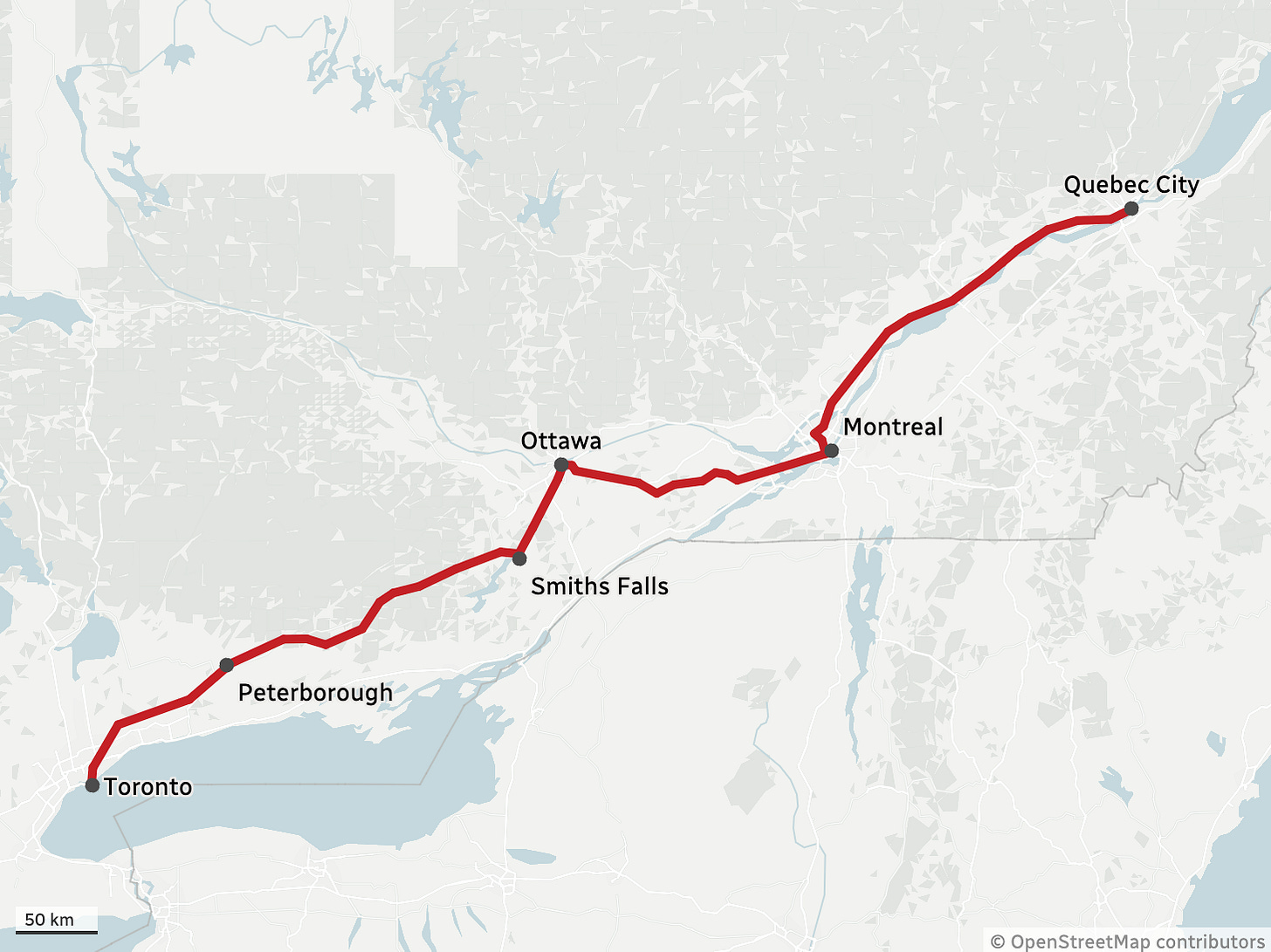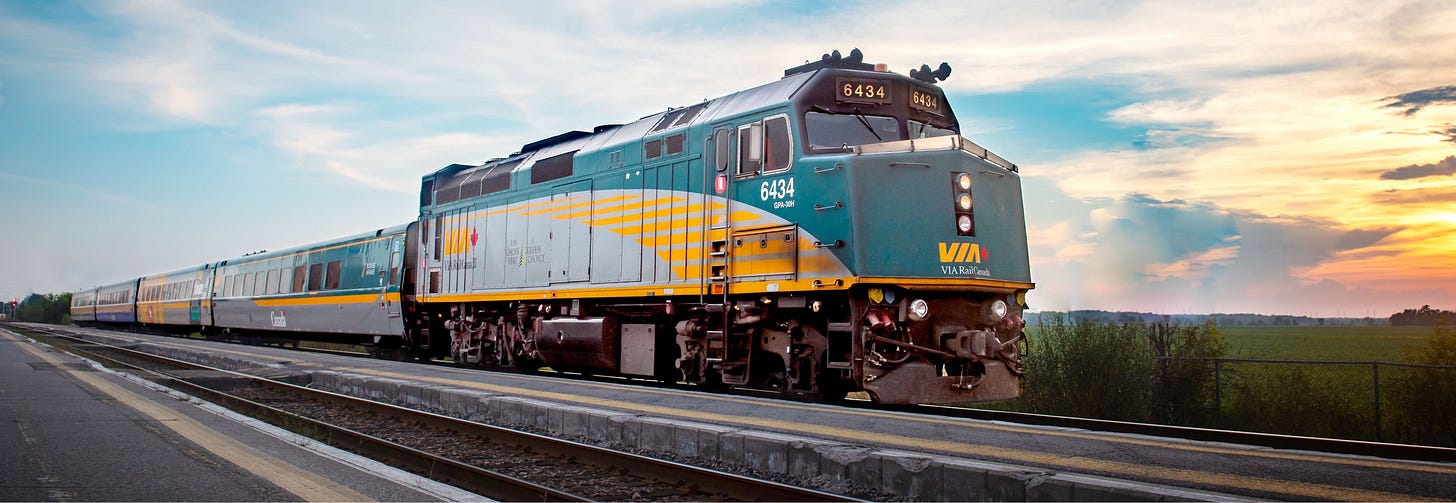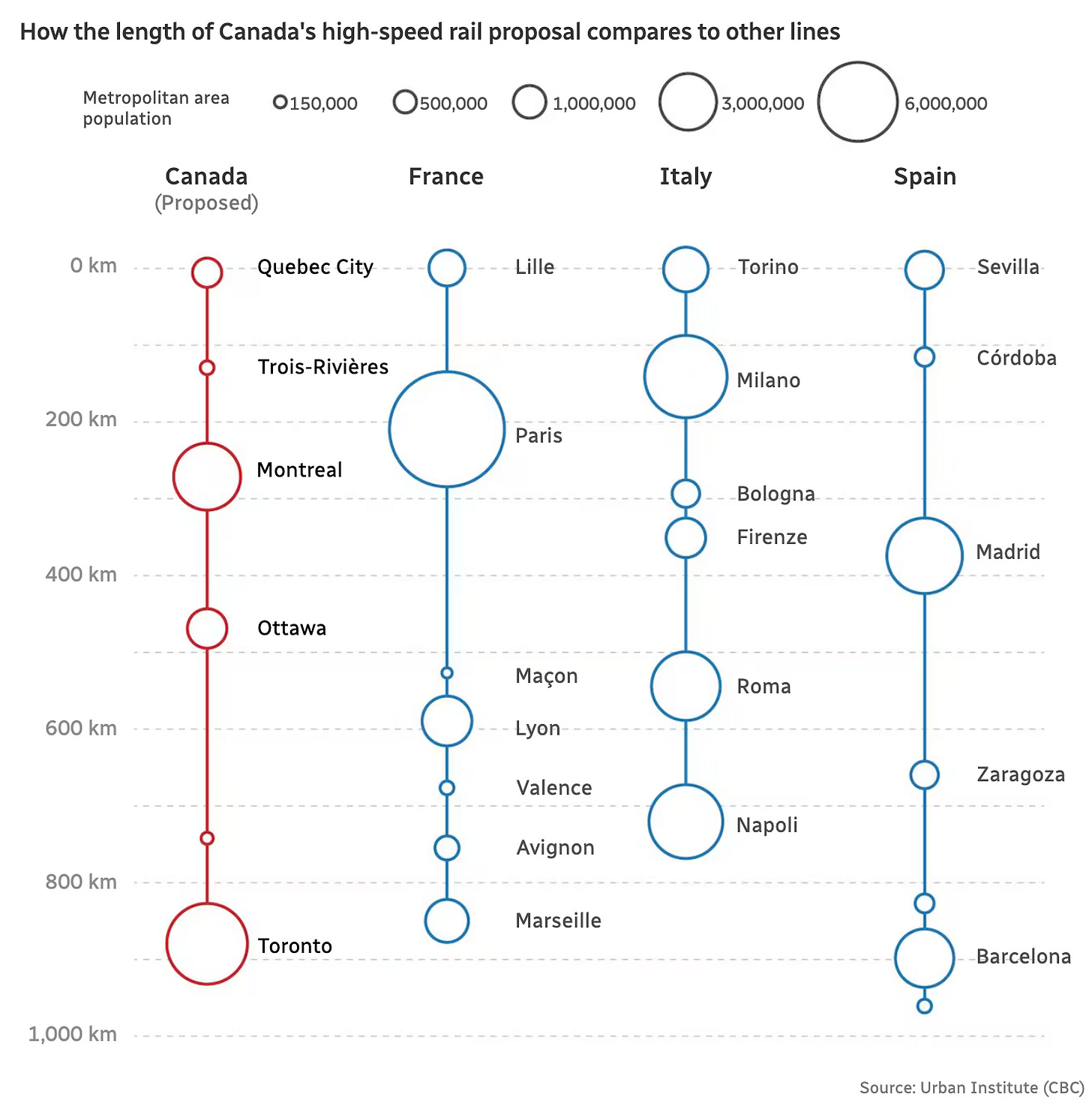Will Canada get high speed rail?
High speed rail in Canada has been talked about for decades — but will it survive a change in government?
Hi there,
Welcome to another issue of The Off Site, brought to you by Aphex. This week, we look at the only G7 country without high speed rail: Canada.
Like their neighbours to the south, Canada has long flirted with high speed rail. Since 1970, there have been 26 feasibility studies. Projects have been announced — and abandoned.
In October 2024, it seemed like the wait might be over. The federal government announced that their ‘High Frequency Rail’ project between Toronto and Quebec City would be upgraded to high speed rail.
So far, so good. But what does this mean for transport in the region? And what are the likely bumps along the (rail)road?
Let’s dive in.
Toronto to Montreal in three hours
The proposed project will create a new, largely electrified high speed railway between Toronto and Quebec City.
If the line expands to Windsor in southwest Ontario, the line would serve over half of Canada’s population — including its two biggest cities.
With top speeds of up to 300 km/h, the line will take passengers from Toronto and Montreal in three hours, much faster than car or existing rail routes, and competitive with total trip times by plane.
While nothing official has been released, some reports suggest it might cost between $80 and $120 billion.
What’s wrong with the existing rail service?
The project will replace the existing train service in the corridor operated by VIA Rail, Canada's national passenger railway company.
This service is notoriously slow and unreliable, primarily because the tracks VIA Rail uses are actually owned by freight railways (primarily CN Rail). This means passenger trains yield to the more lucrative freight traffic, causing delays and inconsistent travel times.
Right now, VIA Rail trains operate at speeds of 60 to 120 km/h along most of the route. For passengers, the problem is only getting worse. Passenger trips along the line are one hour slower than they were in the 1970s.
Is Canada too big for high speed rail?
So, there’s a good case for better rail service along the line. But is high speed rail necessary?
One criticism is that Canada’s population is dispersed across an enormous area, making high speed rail impractical. This is contrasted with the compact geography of Europe, which is often seen as the poster child for successful high speed rail projects.
While there’s no disputing the enormous size of Canada, the population density along the proposed route is actually not dissimilar to major European lines.
This excellent infographic from the CBC makes the case that the proposed line would serve a similar population along a similar distance as successful projects in Italy, France, and Spain.
High speed — or high frequency?
The original proposal for the line from VIA Rail was for a high frequency rail service.
The ‘high frequency’ proposal aimed to build new purpose-built tracks that the existing trains could use, without competing with freight. This would allow them to offer a faster, more reliable, and more frequent service, without the likely cost blowouts of a high speed rail line.
In October 2024, this proposal was changed to full high speed rail — apparently as a result of discussions with consortia bidding for the project.
However, as of writing, the official website for the line is still ‘HFR’ — high frequency rail — and much of the official communication hasn’t caught up with the new high-speed approach.
Who’s building it?
Three consortia were invited to bid on the project in 2021:
Cadence (CDPQ Infra, SNC-Lavalin, Systra Canada, Keolis Canada)
Intercity Rail Developers (Intercity Development Partners, EllisDon Capital, Kilmer Transportation, First Rail Holdings, Jacobs, Hatch, CIMA+, First Group, RATP Dev Canada, Renfe Operadora)
QConnexiON Rail Partners (Fengate, John Laing, Bechtel, WSP Canada, Deutsche Bahn)
The winner is expected to be announced soon.
According to reports, the work of the consortia to date is the primary reason why the project has evolved into a high speed service.
As the CBC reports:
According to a government source, the consortia's work demonstrated that the high-speed rail option was ‘much less expensive than originally anticipated.’
The economics of high speed rail
With the cost blowouts in projects like California High Speed Rail and HS2 in the UK, it’s easy to be skeptical of consortia talking down the costs of high speed rail.
While the cost of the line will be high — potentially north of $100 billion — the benefits are clear. The CBC spoke with John Gradek, a faculty lecturer at McGill University, who calls the project a no-brainer.
Gradek suggests that the money will be spent on transport infrastructure, one way or another. With over 150 daily flights between Montreal and Toronto, more road and airport infrastructure is sure to be required if high speed rail isn’t delivered
According to transport commentator Reece Martin in The Hub, the cost would be much more manageable if the project was limited to Toronto and Montreal. As we saw with California High Speed Rail, cost blowouts on megaprojects can be caused as much by political decisions as technical challenges.
Will it actually get built?
The design process for the high speed rail process is likely to last 5 years. If the Liberals fall from power in the next election, there’s every chance the project could be cancelled.
This is exactly what happened to a high speed rail project in Ontario announced by the Liberal government in 2017, only to be abandoned in 2022 when Conservatives led by Doug Ford came to power.
Critics also point to the slew of major transport projects in Canada running over budget and behind schedule, from the Réseau Express Métropolitain, scheduled to open 7 years later than planned, to the Ontario Line, which has escalated in costs from $10.9 billion to $27.2 billion.
That said, the Policy Declaration of the Conservative Party of Canada says:
We support rail infrastructure across Canada, including innovative high-speed passenger rail where warranted.
For proponents, there is enough to be cautiously optimistic that the project will proceed in some form, regardless of who is in power.
What we’re reading this week
New Civil Engineer covers the award of the $1.18bn contract for the Manhattan Tunnel Project to a Frontier-Kemper and Tutor Perini joint venture. This is part of the $16bn Hudson Tunnel Project.
From Roads Online, STRABAG completed their acquisition of Australian building and civil construction company Georgiou Group after the deal was approved by Australia’s Foreign Investment Review Board.
Construction Briefing outlines three ways President Trump’s recent flurry of executive orders could impact construction.





